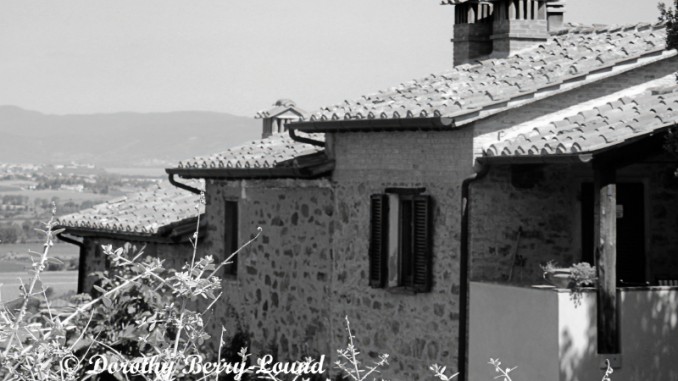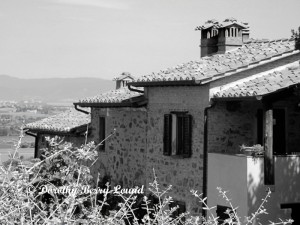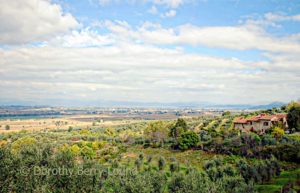
Someone asked me a really good question, what is the history of your house? Do you know, I had to think about the answer.
What Is The History Of Your House?
First Response
My immediate answer was a practical response. That the house was originally in three parts. My ex-husband and I bought the first part of the house from an English author. I didn’t even get out of the car before I decided it was perfect, just from the look of the house and the wonderful views. You get an idea of that from this photograph ‘Roof View’.

Some years later we bought the second part of the house, also from an English couple. Then finally the back part of the house was purchased from an Italian film director. Over the years I have restored and converted it. That was my answer.
A More Considered Response
Afterwards I was thinking about ‘what is the history of your house?’ and I realized I was thinking in rather narrow terms.
The House Grew Over Time
Like many old Italian country houses it will have started much smaller than it is now. In fact, you can clearly see the older part of the house and where it has been extended, right down to where a window has been blocked in and is now part of an internal wall (I have made features of those as I rather like them). Traditionally, the daughters moved in with their husbands and the sons had their wives come to live with them, which often entailed building on an extra room.

Animals Were Kept Underneath
Of course not so long ago the downstairs of the house was given over to animal rooms. Our dining room is over what was once an old pigsty and is now a bedroom. Keeping the animals downstairs over winter provided additional warmth to the house as the heat rose from the animals below. One of the non restored rooms below, that houses cat beds and a large sofa for them to sleep on, still has the original animal mangers.
Our bedroom is the old cantina of the house, it had old olive and wine vats and oak barrels – our en-suite bathroom used to be used for smoking meat and had a black ceiling when we bought the house. We had to have sandblasted before we could use it. The outside oven had a storage space and when we demolished it to build my art studio on the back of the house it was full of maize! That was obviously being stored as animal feed. You can imagine the family that lived here in those days slaughtering and smoking their own animals and growing and making their own olive oil and wine. I often think of them standing looking at the wonderful view.
The Red Brigade
Thinking more widely about the history of the house, in one of the downstairs rooms there is the sign for the Red Brigade painted on the wall and local tradition has it that members of the Red Brigade evaded the authorities by hiding in the house. The Red Brigade (Brigatte Rosse) was a left-wing paramilitary organisation that was notorious for its attempts to de-stabilise Italy in the 1970s and 80s. They famously kidnapped and murdered the former Christian Democrat Prime Minister Aldo Moro in 1978.
The Second World War In This Part Of Italy
The old couple that used to own one of the olive groves below us would often stop to chat on their way past our house. The old gentleman would tell me about the Second World War and how the English Tommies hid in the mountains behind us. He used to take provisions up to them on the back of a donkey.
Indeed this whole area is well documented for the activities that took place during World War II. The Trasimene Line was a German defensive line during the Italian Campaign. One book written on the subject ‘The Trasimeno Line June-July 1944‘ is full of old black and white photographs of the many towns and villages around us, showing the movement of troops and the war damage.

I recently watched a World War II re-enactment parade locally. It featured some of the original military vehicles that were involved in the liberation of Italy during the war. It was an odd feeling to see them follow the roads that were originally used. I tried to imagine what it was like for the people living here. I have to say it is amazing to think that battles took place in the fields below us. Where now I take photographs or paint poppies and sunflowers.
So my answer to ‘What is the history of my house?’ was a mere snapshot in time – don’t get me started on Hannibal and the Battle of Lake Trasimene in 217 BC…
This article was originally posted in 2015 and was updated and republished February 2022.
Before you go

My name is Dorothy Berry-Lound an artist and writer. You can find out more about my art and writing at https://dorothyberryloundart.com.
You can follow me on Facebook.
Thank you for reading!

Wow! This is such an interesting pos 🙂 I need to do some research about my old house- I know it was build in the early 1900s but nothing else. Thank you for sharing x
Glad you found it interesting Eleanor. Thanks for your comment.
Very cool! I don’t think my house has much history but it’s so interesting learning about anyone’s house history. My friend has a very very old farm house she’s been researching the history of. Fun to learn!
What a really interesting history — it was great to read about it. It makes me want to research my own home which I know is pretty old. Thanks for the inspiration to do a bit of research.
It is fascinating once you start. Thanks for your comment Molly.
Glad you enjoyed it Chelsea. It is funny what you find out once you start looking
Oh this was super interesting to read! It’s fascinating how the area was used during World War Two, and as an avid history lover I definitely want to find out more about my house’s history! Thanks for sharing.
Glad you found it interesting. Funny how an innocent question can lead to something really revealing about where you live. Thanks for your comment
That’s so cool that you managed to find out the history of your property. I love hearing about the personal little stories that often get forgotten, such as the villager who used to take supplies to the soldiers. The enactment would have been really cool to see. I love hearing of your experiences living in an Italian village.
I am glad you found it interesting Lindsay. The re enactment was actually quite emotional as you could (almost) imagine what it must have been like when it actually happened. Thanks for your comment.